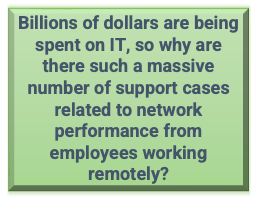Hybrid Work Model
The hybrid work model has evolved into a necessary business continuity plan for enterprise business leaders across the globe. Enterprises have experienced how hybrid work can enable them to continue business operations in times of adversaries like COVID-19 or hurricanes. Besides business continuity, the hybrid work model will have other benefits, such as overall employee well-being [1] (work-life balance) and cost savings for the company.
A hybrid work model is a type of workforce structure wherein employees can choose where they wish to work, such as from their own home or a central location like an office building. This is advantageous for many businesses since it allows them to access talent that may not be available in a particular geographic area.
The hybrid work model can become successful only when a combination of technological and process/procedural factors are put in place correctly. While human resources departments are handling the process/procedural factors, IT and security teams are busy figuring out the technological factors.
For hybrid work success, IT and security teams of all enterprises are continuing to invest in the technology that is required for hybrid working. These teams are buying best-of-breed technologies for security (data security, app security, identity security, endpoint security), collaboration (Office 365, G-suite, Teams, Zoom, etc.), and cloud infrastructure.
With billions of dollars spent on IT and security, why do the network administrator and support teams still face a massive number of support cases related to application and network performance from their hybrid workers who are working remotely[2]?

Network Performance Issues
While IT and security teams can provide secure access to the necessary applications and data sources, several factors are impacting remote employees' work experience and productivity.
One factor that hugely impacts employee experience in the hybrid work model is the local network and WAN problems that stem from their remote connectivity architecture. Remote workers (home, coffee shop, hotel, airport, etc.) usually connect the endpoint to the Wi-Fi or LTE network, plugged into the ISP's local point-of-presence (PoP). These two network segments (endpoint to Wi-Fi, Wi-Fi to nearest ISP PoP) are highly prone to network problems for various reasons.
Below are examples of common network issues that impact remote workers in their hybrid workplace and can cause packet loss over these network segments.
- The home Wi-Fi network is shared by other members of the family who might be streaming some online game or video.
- Poor in-home Wi-Fi local network performance due to interference from neighbors, too many network devices competing for the Wi-Fi bandwidth (TVs, phones, doorbells, cameras, lights, etc.)
- In a crowded place like an airport, the LTE or public Wi-Fi network would be heavily loaded because almost everyone is connected online.
- The network issue impacting remote employees at a coffee shop might be that the Wi-Fi router is placed next to an oven or coffee machine, which can interfere with the Wi-Fi signal.
- There might be obstructions that reflect or absorb the Wi-Fi signal impacting signal strength, or if it is a reflected signal, it can completely cancel out the original signal. Wi-Fi network coverage is non-uniform, so some areas will have poor coverage.
- The ISP PoP is under maintenance or over-subscribed, so network issues occur, with the result that packets get dropped.
Consumer-grade ISP connections have network problems because they are delivered to the remote workforce on a “best-effort” basis and are not backed up by the service-level agreements that a business would have. Hence, the ISP network link quality can deteriorate sporadically, and remote workers can do nothing about it. Another impact of these local network issues is that the network latency between the VPN endpoint and the application will increase. This in turn, leads to the degradation of application performance.
Unfortunately, these temporary network problems are sufficient to degrade the application performance severely. A typical TCP-based application follows an aggressive back-off model when common network issues appearing as congestion are detected (triggered by a few packet loss events) and applications become very slow. Even video conferencing applications such as WebEx, Teams, and Zoom, which are using UDP, are not immune to these network problems. Imagine an audio and video conference call where a user’s voice is breaking, and their video is frozen for a few seconds. The call will not go well and this creates a sense of frustration among participants[3].
Now, if this call is with a customer from the sales or the support organization, it will result in a loss of business and damage to the brand's reputation.
It is not the average network packet loss rate that matters but the intermittent peak packet loss rates occurring during the call or an important file upload/download. For example, the average packet loss rate might be very small, like 0.001% over the day, but a peak drop of 5%, which might only happen for a few seconds, will severely impact the conference call quality or application experience. What matters the most in overcoming network problems is the consistency of the quality of experience, and not a good quality most of the time.
Here comes HAaaS
The traditional VPN infrastructure was meant to securely connect users to data centers when occasionally working remotely. With the original concept of the VPN, it was expected that employees who work remotely would have physical connectivity issues. Therefore applications and workflows were designed for intermittent connectivity. However, fast forward to today with the roll-out of fast networks almost everywhere and the adoption of Cloud and SaaS apps, hybrid work success relies on remote users having the same performance and security as onsite employees. VPN can’t scale to the new requirements where a large percentage of users are connected to data centers throughout the day to access their applications and data. This results in severe performance degradation for private applications hosted inside physical data centers or in public/private cloud VPCs. SD-WAN solutions can’t help remote users because it will be a nightmare to deploy and manage branch SD-WAN edges for each of the users. Also, these edges can’t move with the user when traveling.
Enterprises are trying to adopt not just one but two major trends at the same time – hybrid work and multi-cloud – that have put focus on access technologies recently. A new disruptive solution must arise to overcome the challenges posed by these new trends and reap the benefits of the hybrid work model - enter Hybrid Access-as-a-Service.
[1] https://www.gallup.com/workplace/398135/advantages-challenges-hybrid-work.aspx
[2] https://www.splashtop.com/pt/wp-content/uploads/ESG-eBook-Splashtop-May2022.pdf?
[3] https://www.gallup.com/workplace/398135/advantages-challenges-hybrid-work.aspx
